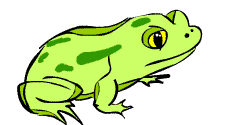    



|
|
Plains Spadefoot
Limiting Factors
 Limiting factors are those that lower
habitat quality or decrease survival and reproduction. Various factors that may affect Plains Spadefoots have been suggested, but few of these have been investigated as to their specific impacts. The population size of the Plains Spadefoot is likely limited by the availability of breeding and wintering habitat. The following section discusses factors that may affect breeding and wintering habitat with an emphasis on human-caused
impacts such as Habitat Alteration and
Destruction, Oil and Gas Exploration and Development, and
Road Kills. Limiting factors are those that lower
habitat quality or decrease survival and reproduction. Various factors that may affect Plains Spadefoots have been suggested, but few of these have been investigated as to their specific impacts. The population size of the Plains Spadefoot is likely limited by the availability of breeding and wintering habitat. The following section discusses factors that may affect breeding and wintering habitat with an emphasis on human-caused
impacts such as Habitat Alteration and
Destruction, Oil and Gas Exploration and Development, and
Road Kills.
 Habitat Alteration and
Destruction: It is estimated that up to
77% of native Canadian prairie has been lost to cultivation, roads, urbanization and other human activities. In Alberta, up to 61% of native prairie in the Mixedgrass Ecoregion has been lost. Agriculture, which is responsible for the conversion of most native prairie habitat, may be the largest, most important threat to the Plains Spadefoot. Cultivation and drainage of
wetlands, and flood control have been identified as threats to the Plains Spadefoot in Alberta. The extent to which the highly fragmented prairie landscape affects toad movements between populations or the re-colonization of
extirpated populations is not known. However, if breeding wetland basins are cultivated during dry years, the ability of those basins to hold water in wet years may be affected. Although Plains Spadefoots have been observed in cultivated areas, the extent to which successful breeding occurs and how their movements across or use of this habitat type outside the breeding season is affected is unknown. Habitat Alteration and
Destruction: It is estimated that up to
77% of native Canadian prairie has been lost to cultivation, roads, urbanization and other human activities. In Alberta, up to 61% of native prairie in the Mixedgrass Ecoregion has been lost. Agriculture, which is responsible for the conversion of most native prairie habitat, may be the largest, most important threat to the Plains Spadefoot. Cultivation and drainage of
wetlands, and flood control have been identified as threats to the Plains Spadefoot in Alberta. The extent to which the highly fragmented prairie landscape affects toad movements between populations or the re-colonization of
extirpated populations is not known. However, if breeding wetland basins are cultivated during dry years, the ability of those basins to hold water in wet years may be affected. Although Plains Spadefoots have been observed in cultivated areas, the extent to which successful breeding occurs and how their movements across or use of this habitat type outside the breeding season is affected is unknown.
Disturbance of wetlands by cattle has negatively affected other amphibian species and may have a negative impact on the Plains Spadefoot. In British Columbia, cattle prints in breeding wetlands trap Great Basin Spadefoot tadpoles preventing them from reaching deeper areas of the wetland as it dries. High turbidity, with high nutrient loading from cattle feces, resulting in greatly reduced dissolved oxygen content has been linked to complete die-offs of Tiger Salamanders
at Suffield National Wildlife Area and may have impacted other amphibian species.
The widespread use of herbicides and pesticides can also have negative effects on amphibian development, habitat quality and prey species. The specific effects of these chemicals on Plains Spadefoots is unknown. It is also not known how species that utilize temporary wetlands are affected by water management projects such as damming of creeks, construction of dugouts, or creation of permanent wetlands in temporary wetland basins. These water management strategies may benefit some wide-ranging species that do not normally occur in an area to the detriment of species already occurring in the same area such as the Plains Spadefoot. Water management projects may also have an effect on local ground water thus hindering the formation of temporary wetlands.
Oil and Gas Exploration and
Development: Activities associated with the oil and gas industry are common throughout the Alberta range of the Plains Spadefoot. Disruption of groundwater resources, ground and surface water contamination, and the consumptive use of water sources by drilling activities are potential threats to the
Great Plains Toad (Bufo cognatus) in Alberta. These activities may also pose a threat to the Plains Spadefoot which occurs in many of the same areas as the Great Plains Toad. Plains Spadefoots are likely to get trapped in sunken gas well caissons and open pipeline trenches. Great Plains Toads were found trapped in caissons
at Canadian Forces Base (CFB) Suffield and at the Suffield National Wildlife Area. Pipelines regulated by the Natural Resources Conservation Board are usually constructed during late summer to early winter to avoid the sensitive spring breeding season. This construction schedule helps reduce the impacts to Plains Spadefoots and other amphibians.
Road Kills:
Documentation of Plains Spadefoots in some areas has been as a result of observations of the species on roads at night. Many fall victim to vehicles, especially when large numbers of toads are migrating to breeding wetlands. An additional effect of oil and gas activity is the increased traffic on roads resulting from pipeline development or maintenance of wells. During a pipeline construction project in eastern Alberta, numerous juvenile Plains Spadefoots and Canadian Toads
(Bufo hemiodhrvs) were found on a sandy road adjacent to the pipeline right-of-way.
Reprinted from Alberta Wildlife Status Report No. 25
(1999),
with permission from Alberta
Sustainable Resource Development.
[Introduction][Alberta
Home][Limiting Factors][Status][Management]
|
 Heritage Community Foundation Presents
Heritage Community Foundation Presents









 Limiting factors are those that lower
Limiting factors are those that lower
